#Metroid dread spoilers
Explore tagged Tumblr posts
Text

#metroid samus#digital art#my art#samus#samus aran#samus fanart#metroid fanart#metroid#metroid suit#metroid dread#spoilers#metroid dread spoilers#chozo#power suit
931 notes
·
View notes
Text

“Samus, I heard that Raven Beak has an 8-pack. That Raven Beak is shredded.”
#Raven Beak#Metroid Dread#Metroid#Samus#Raven Beak hyping himself up while posing as Adam is the goofiest shit and I love it#Metroid Dread spoilers
204 notes
·
View notes
Text

"Your very existence poses a grave threat to the galaxy."
323 notes
·
View notes
Text
X/twitter Link
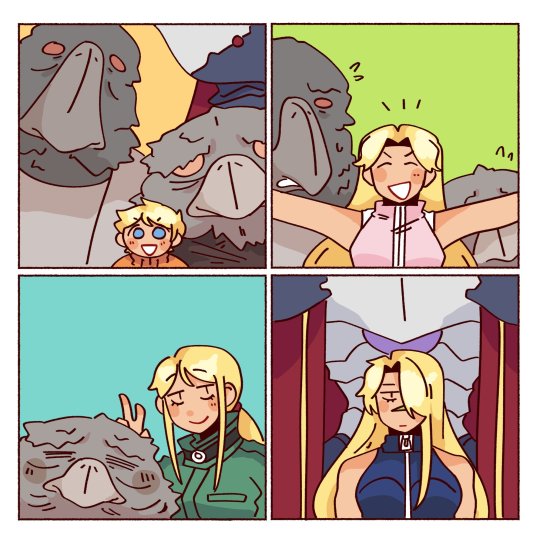

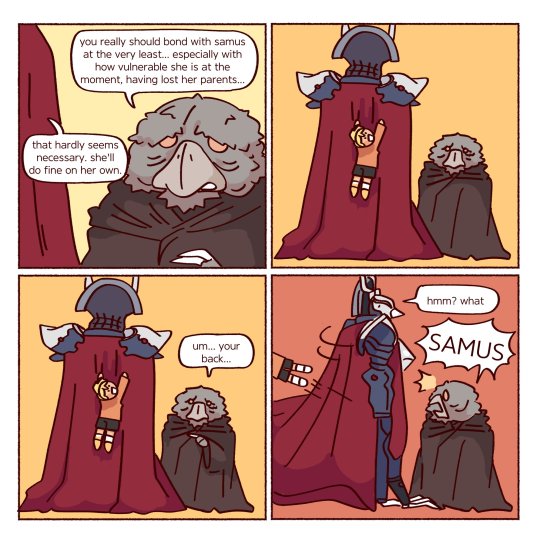
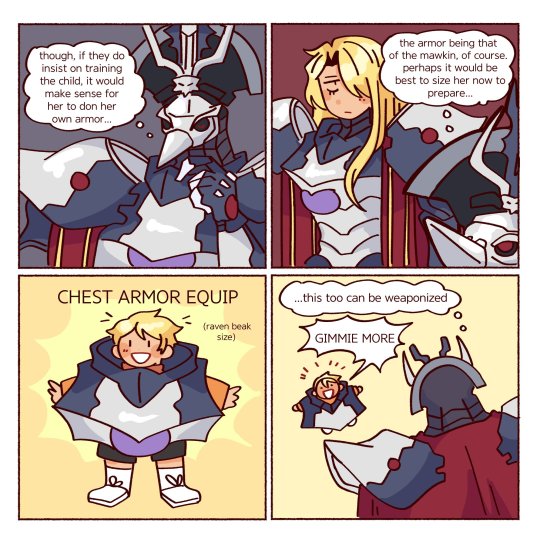
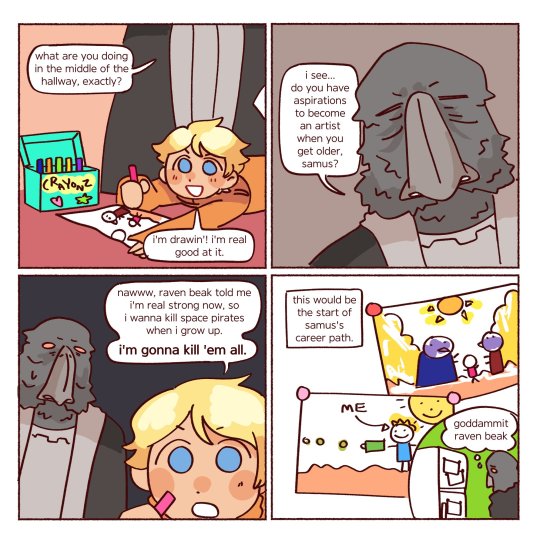

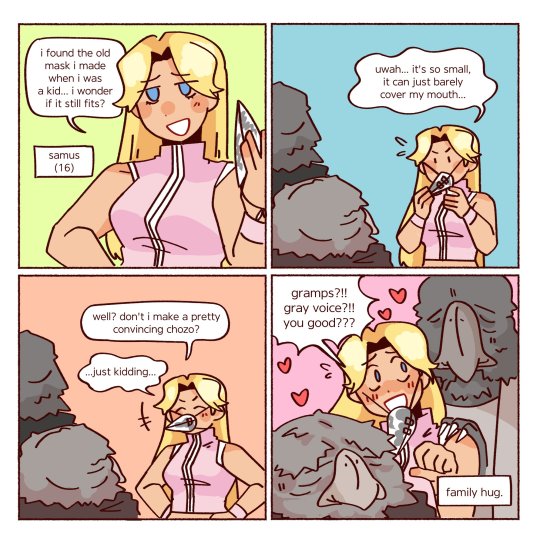
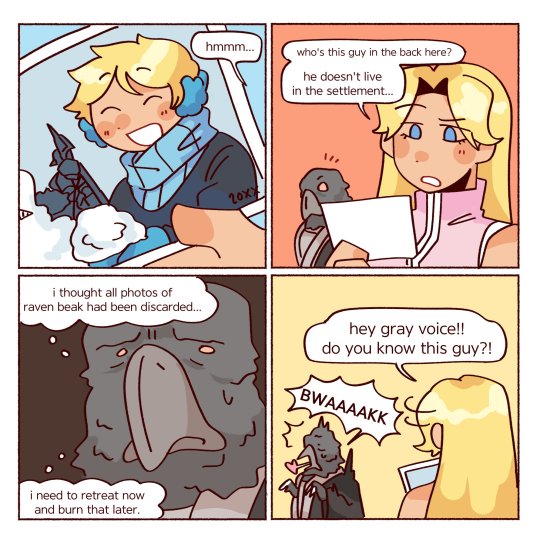

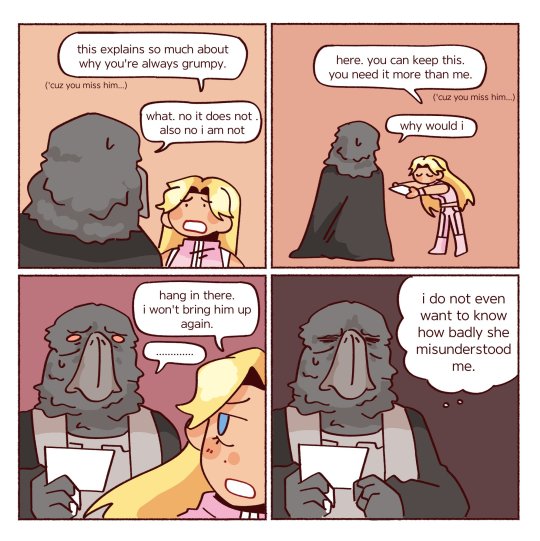
701 notes
·
View notes
Text
Samus Aran started out as a goofy parody of the cool-as-fuck deep space bounty hunter archetype, but then Nintendo decided that she needed a more serious personality makeover, and what they came up with was giving her a strident obsession with motherhood and a propensity for pathological approval-seeking toward whatever random surrogate father figure happened to be in the room, because those are Woman Personality Traits, right?
Then along comes Metroid Dread, whose story is very much a response to that era of the franchise, but all of Samus' various father figures are already dead at that point in the timeline, so the game is obliged to invent a new dad for Samus purely so she can kill him.
#gaming#video games#samus aran#metroid#metroid dread#nintendo#violence mention#death mention#swearing#metroid dread spoilers#metroid spoilers#spoilers
3K notes
·
View notes
Text
After referencing numerous diagrams, avian necropsy records, and my own prior knowledge of human musculoskeletal structure, I have devised speculative anatomical structure for Chozo.
We'll start small with my first attempts to properly chart basic skeletal structure from last year (seeing as how that's what I used as a jumping off point), then move on to the research-based stuff. I wanted to walk through the process of solving problems presented by the skeletal structure.
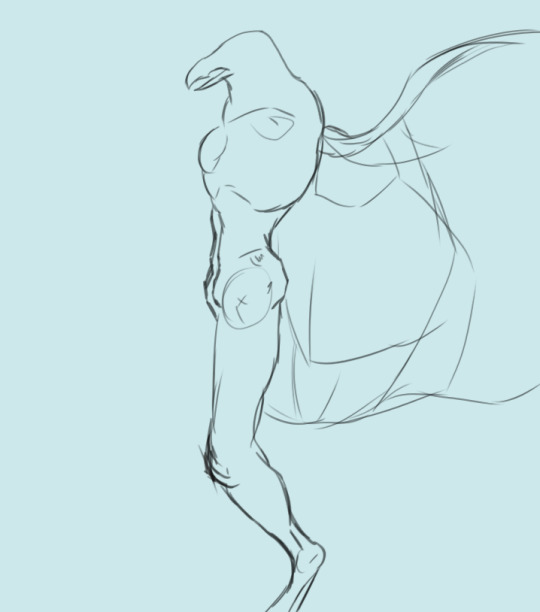
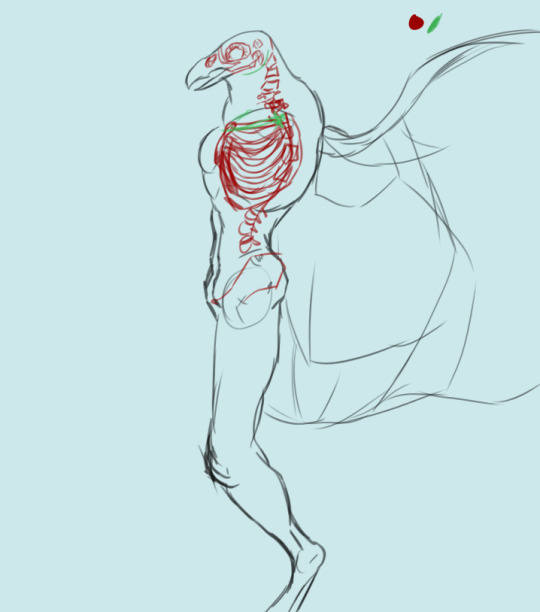
First we have a cursory look at the ribcage. Drafted June 7, 2023. Leaning into the more humanoid appearance.
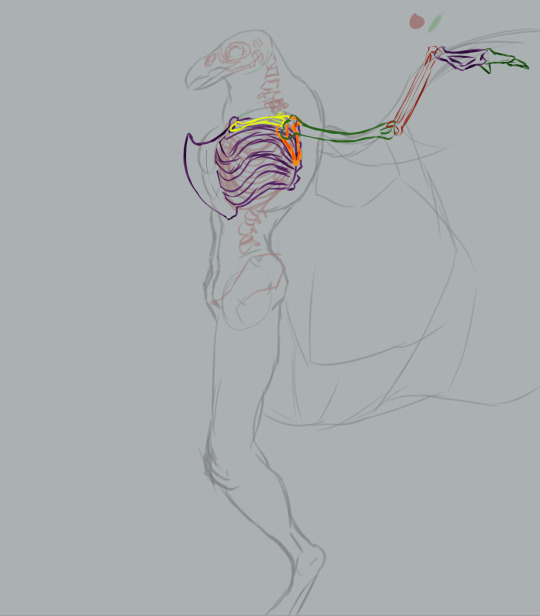
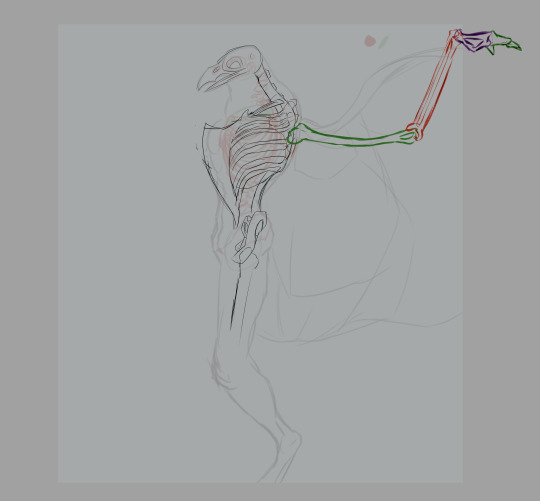
New addition, May 2024: a first shot at sussing out wing bones. These bones need to be much, much larger to accommodate the full breadth of the limb: this is just a rough outline. The skeleton also needs to bear muscles that are strong enough to carry the Chozo in flight, hence the new protrusion on the chest: a keel. Two variants of this new breast came out of this drawing session: one with a large keel that extends below the sternum and one with a normal keel.
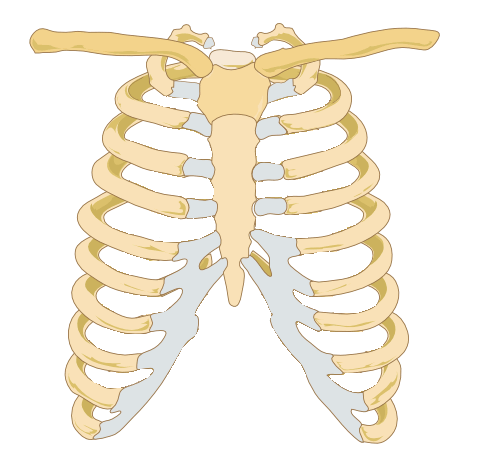
Image credit: Wikipedia
Human ribcages have this ridge along the bottom that the last six ribs are attached to (noted in grey on the image above). We're not doing that with the Chozo ribcage.
The sternum is the structure in the middle, which the ribs are attached to. See those two bones attached to the top of each side of the sternum, stretching away from the center of the ribs and forming sort of a capital "T" silhouette? Those are the clavicles. When you're drawing any humanoid form, the clavicles are an excellent landmark (and as I've been taught, the first place you should start on anatomy after you've laid out your pose, armature, etc).
It's also part of why wings are so difficult to suss out on Chozo skeletons. In birds, a bone that consists of a fusion of the two clavicles is a crucial part of flight: the clavicle bridges the gap between the ribs and the arms, and for birds, the wings are their arms. That's problem number one: effectively consolidating two pairs of arms on one torso.
We have a few bones to add onto the human skeleton in order to make flight possible for Chozo. First, we'll assume all bones are hollow. This makes them lighter, demanding considerably less energy to lift them off the ground in the first place.
I've modified the sternum to add a keel, which the base flight muscles are going to be anchored to.
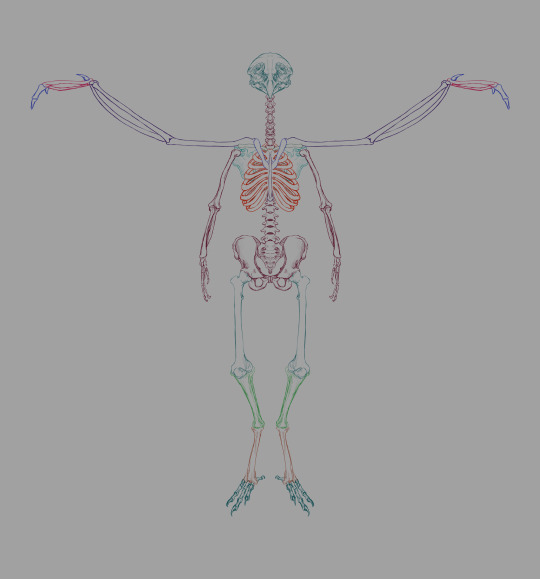
First pass at revising the skeletal structure. I made a few modifications unrelated to the wings. The pelvis is similar to that of a human, though a little wider to accommodate egg-laying. I may end up reworking the pelvis entirely to make it more bird-like, but I'm more interested in making those wings fit at the moment. Chozo have a human femur/patella, and avian lower legs.
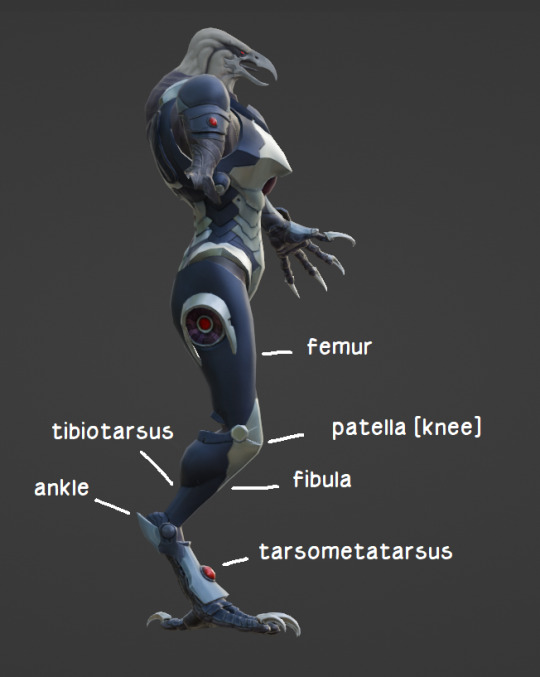
Here's a thing I slapped together in 3 minutes in January of last year to illustrate which bones are where for the layman. Onto different matters.
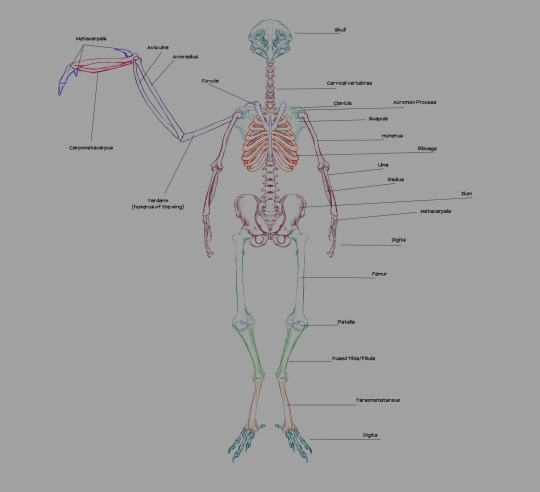
Skeleton, labeled.
Generally, the wings' humerus is attached to the scapulacoracoid, a bone attached to the keel that's sort of Y-shaped. That's how a real bird's shoulders are structured. Humans posses a scapula (shoulderblade), which has two protrusions: the acromion process and the coracoid process. The acromion process is where our humerus joins the shoulder. The coracoid process in humans is not exactly big enough nor ideally shaped to anchor flight muscles to.
At first, I had three ideas:
Invent a new bone attached to the keel that serves the function of the coracoid.
Modify the scapula to fit a new bone that anchors the flight muscles (the scapulacoracoid is analogous to the human scapula, after all).
Forego the keel and invent a bone on the spine that does the same thing.
To start, I added the furcula, a Y-shaped bone on the sternum, flanking the keel. Fun fact: not all birds have a furcula (better known as the "wishbone" in some parts of the world).
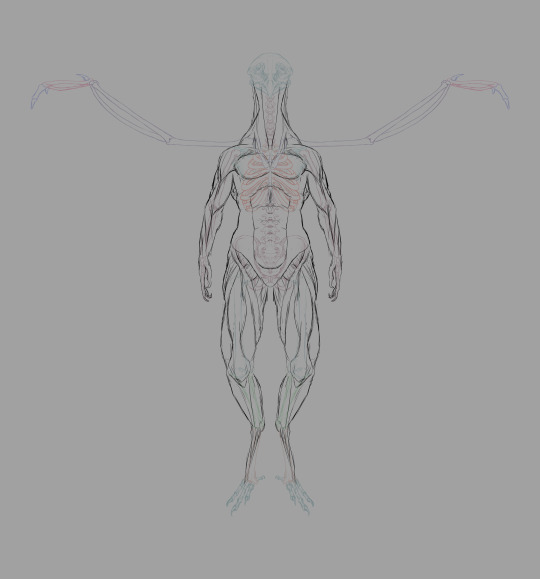
Real quick muscular structure layout sans flight muscles.
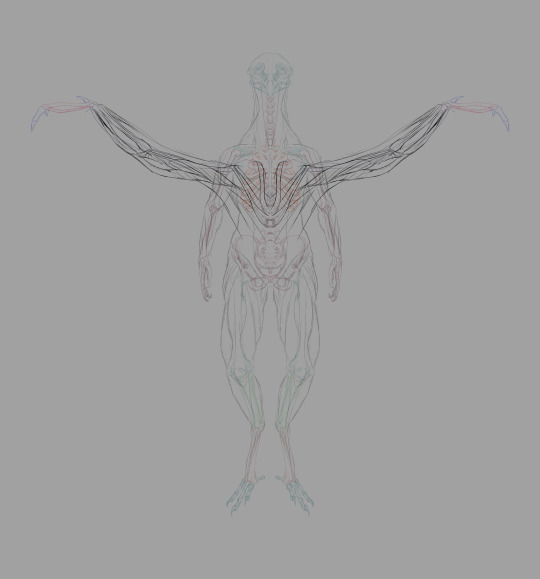
First pass at the flight muscles. Not the most accurate wing muscles in the world (neglected to depict the muscles near the tip of the wing, for one).
In this model of the musculature, a good deal of the flight muscles around the breast and torso are hidden by the pectoralis major, much like several non-flying human muscles.
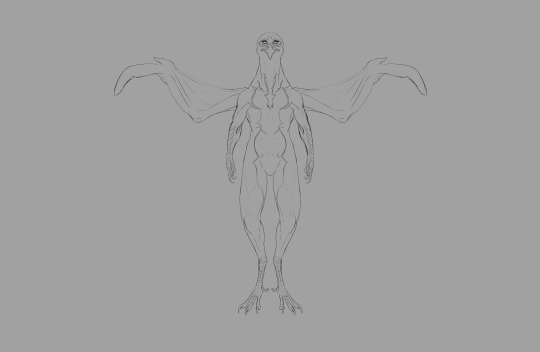
Flesh applied over muscle.
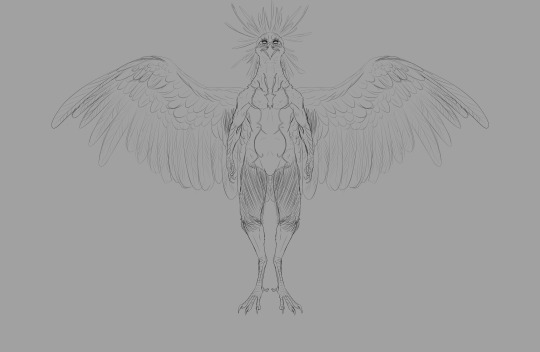
Feathers applied over flesh.
That was my first attempt at constructing the Chozo skeleton. You'll notice the wing bone solution is inelegant. See, wings are analogous to arms. Their metacarpals are finger bones. In order to give Chozo both arms and wings, we'll need to deviate from both avian and human skeletal structures to make the pieces fit together.
I can't make the flight muscles stretch comfortably over the clavicle: that has the potential to impede motion in the arms. My first idea in the second round of flight bone shenanigans was to invent a second bone that fit between the spine and the scapula, like shoulder-bound plate tectonics (working name "scapula trellis"). I wasn't wholly confident that I could configure flight muscles in a logical manner even with this setup.
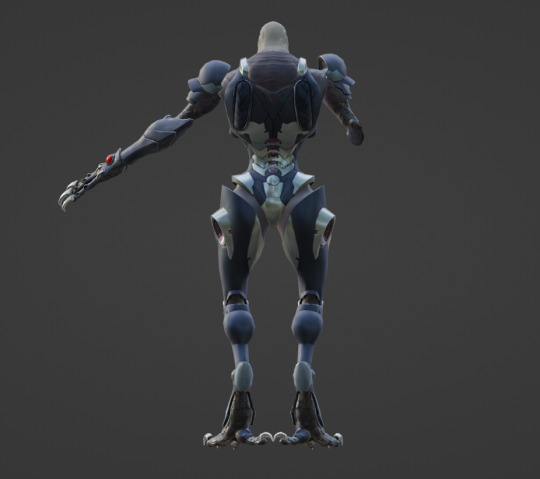
At one point I consulted Raven Beak's model. Note the patches on the back of the torso on the powersuit: that's where the wings emerge in phase 2. It looks like they're anchored to the scapula or an adjacent structure.
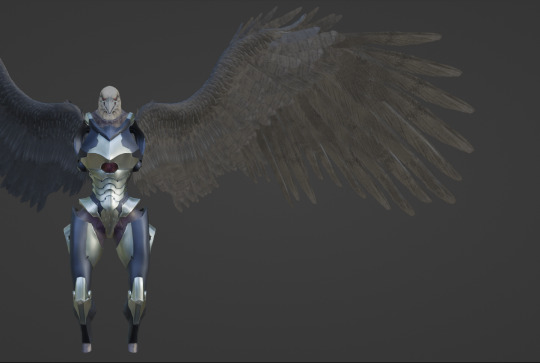
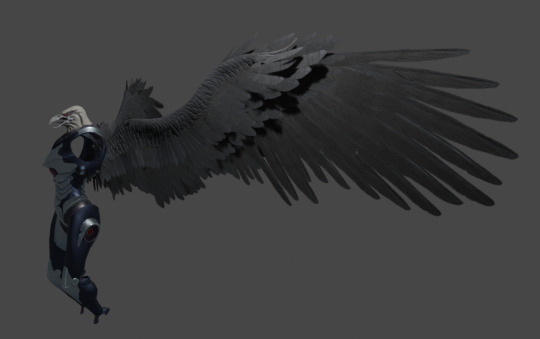
Barring the fact that his wings are absolutely ridiculous, I wasn't sure I could work with this. Gorgeous structures, but the feathers don't seem big enough to handle flight.
So I was left to brainstorm, and drafted up a few sketches for a second scapula to anchor the wings' shoulder joints to. I was more confident in this than I was the previous design, but I wanted to fish for ideas from other parts of nature.
Enter dinosaurs. Specifically, the Pteranodon with its shoulder girdle.
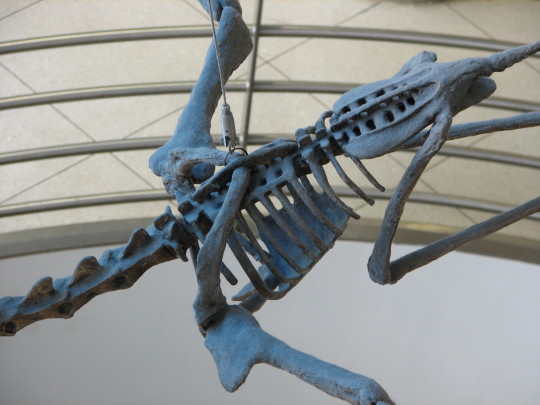
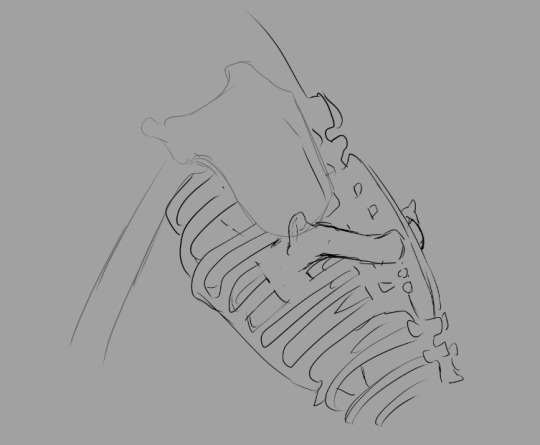
The addition of a shoulder girdle as an anchor for the yardarm (the term I'm using for the humerus of the wing, applicable only to creatures that have both wings and arms) seemed like a better solution. Positioning it below the scapula allows me to place the wings a little lower on the back, providing minimal interference between the two sets of limbs.
Whether we're rolling with the shoulder girdle or a second scapula, the intended result is the same: the wings have moved down on the back of the torso (personally, I'm digging the girdle, but the second scapula is on the table if anyone else wants to try their hand at this).
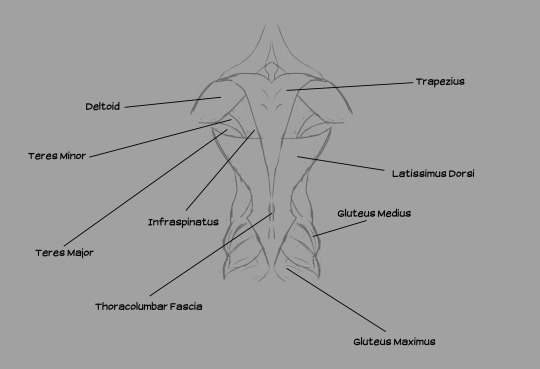
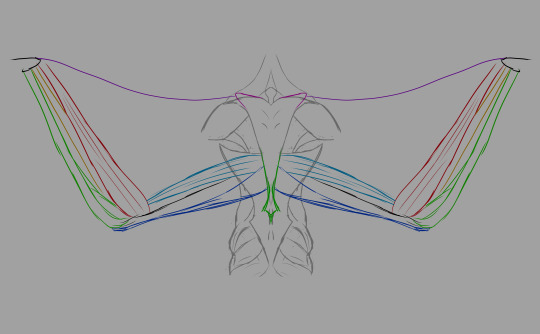
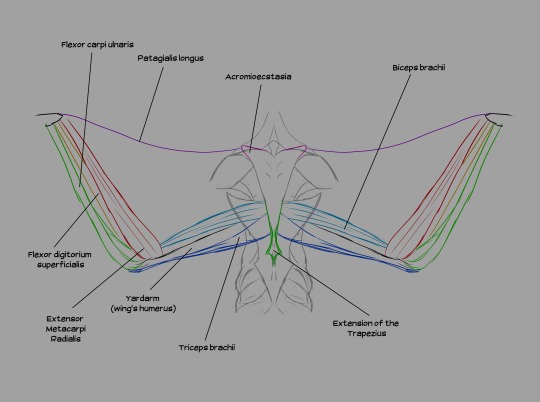
Muscles from the back, illustrated. Note the distance between the deltoid (shoulder muscle) and the wings. The shoulder girdle is situated in the lower-middle of the back of the ribcage.
A few notes: the acromioecstasia exists because the muscle that usually connects between the body and the patagialis longus on real birds is located on the pectoralis major. If I emulated that, we'd have flesh crossing over the deltoid to reach the front of the body, which would obstruct movement of the arms. We don't want that, so I moved that section of the wing to the back. We're compensating by adding additional musculature up front.
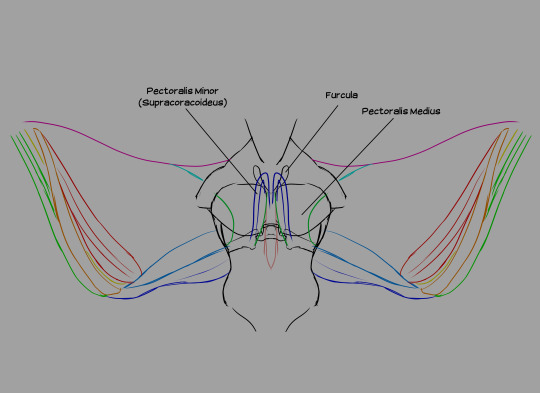
Wing muscles from the front. All three pectoral muscles are attached to the keel. The pectoralis medius is an extension of the pectoralis major, running beneath it and several other muscles. The pectoralis minor (also known as the supracoracoideus) lies beneath both the major and the medius. The pectoralis medius and major are responsible for the downstroke, while the supracoracoideus raises the wing between flaps.
Flight is very taxing on the individual. Power suit wearers actually have an easier time flying than non-wearers because the suit passively offsets the metabolic demands of flight with its own Energy.
It's important to note that these sizes are not necessarily "to scale". Chozo wings should actually be much bigger than my canvas permitted me to show. I had to keep increasing the size of the canvas on one of my files to accommodate a reasonable wingspan, but even that's not broad enough! I had to stop expanding the canvas for the sake of my CPU. If any muscles look too dinky or the scale seems off on some bones, that's why: I just needed to swiftly illustrate where things are.
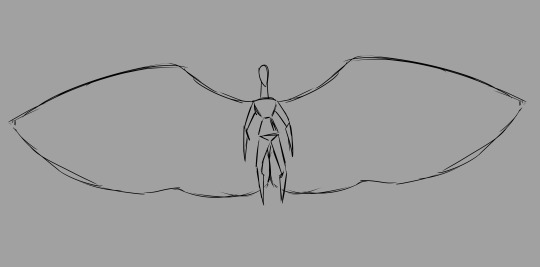
A Chozo's total wingspan should at least be twice the individual's standing height. Any smaller and there's no lift.
I still don't necessarily consider the wings "solved": if any speculative biology enthusiasts want to weigh in further on the subject, feel free!
After laying out the bulk of the skeleton (and before solving the wing problem), I decided to go a little further in my studies. Thus, we have organs.
First, the digestive system.
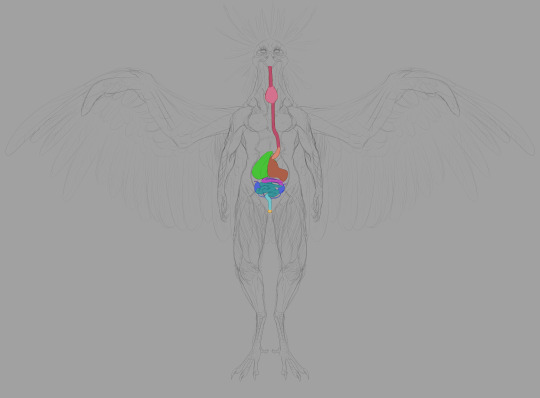
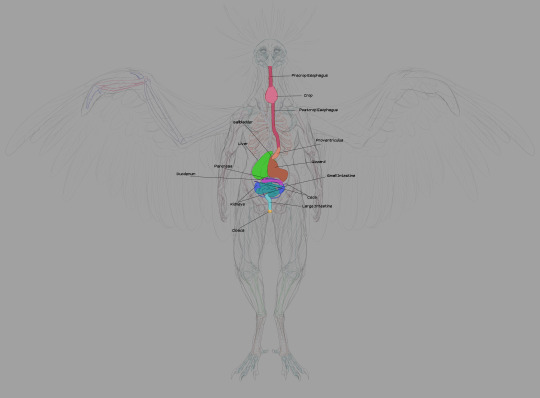
The esophagus is self-explanatory. Food goes in through the beak, traveling into the body through the esophagus.
The crop is used to store food: this is where digestion begins. Many parents regurgitate mushy, enzymatic food for their children from the crop. Very nutritious and promotes growth.
The proventriculus is the first half of the stomach: protein bonds begin to break down here. Gastric fluid produced here aids the gizzard in mushing things.
The gizzard is where the bulk of food-crushing occurs. Breaks larger matter down through transfer between areas within the organ.
The liver and gallbladder are crucial in digesting fats. Real bird livers have two lobes: the left is smaller than the right. Two bile ducts from the liver connect to the distal duodenum: the right duct is connected to the gallbladder. Chozo only need one.
The duodenum is the start of the small intestine, running in tandem with the pancreas. Pancreatic enzymes created by the latter assist in completing digestion, processing sugars, etc.
Digestion is finished in the other sections of the small intestine, where nutrients are absorbed.
Chozo kidneys largely resemble their human counterparts. Connected to the lower half of the gastrointestinal system. Urate is disposed of through the cloaca, transferred from point A to point B by the thin ureters bridging the kidneys to the large intestine.
Bacterial fermentation in the ceca extracts nutrients from plant material that can't be digested through enzymatic breakdown. The ceca and large intestine also reabsorb moisture, forming the solid portion of indigestible waste. The ceca are larger in tribes that eat more fruit and other plant products. Mawkin ceca are fairly small: they live quite an active lifestyle, and plant matter supplements their all-rounder diet with meat as the foremost staple.
The large intestine is the end of the line. Renal and intestinal waste is ejected here. The end of the reproductive tract forks to the distal segment to facilitate egg laying. Mammals have considerably larger large intestines than Chozo to dry out waste before expulsion.
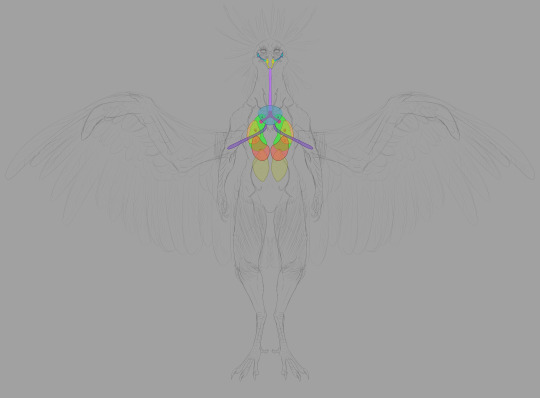
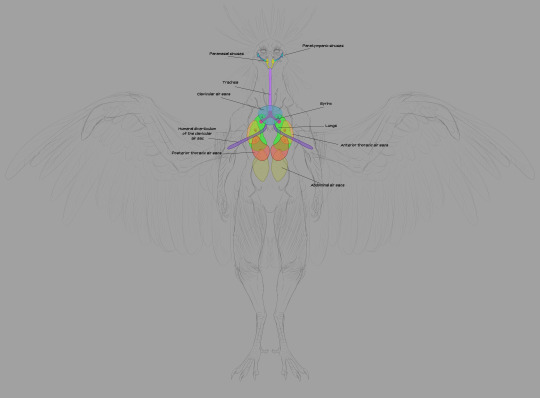
Next we have the respiratory system. The trachea takes in air and delivers it to the lungs. Unlike mammalian lungs, Chozo lungs are inelastic: they don't expand and contract. The air sacs do all the expanding and contracting: they're connected to the lungs through a network of bronchii.
The high metabolic rate required for flight demands a ton of oxygen, and Chozo respiratory organs are designed to do just that. The mechanics are fascinating but I won't take up too much of your time explaining the finer points. Wikipedia's write-up on the circulatory system of birds is a good place to start if you want to dive deeper.
The short version is thus: air enters through the nostrils, traveling into the bronchi through the trachea and syrinx (the syrinx helps Chozo vocalize). The bronchi deliver air to the lungs. When Chozo inhale, the posterior and anterior sacs expand: the posterior sacs take in fresh air while the anterior sacs fill with air that has already passed through the lungs. Air is constantly circulating through the lungs, and it's a one-way flow.
Parabronchii are microscopic tubes that run perpendicular to the blood capillaries. Parabronchii efficiently diffuse oxygen from the air into the blood.
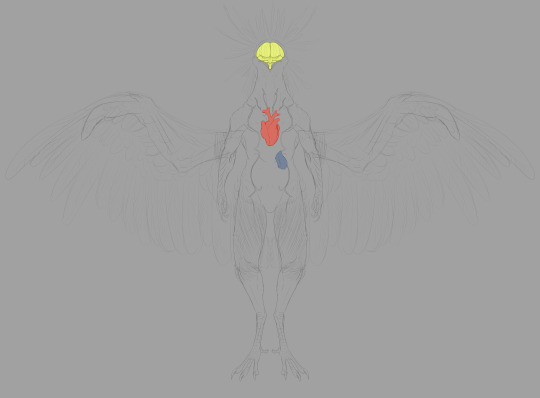
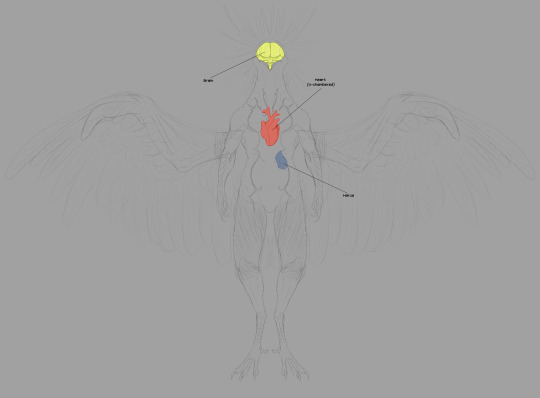
The next image set deals with a few extraneous vital organs. I'm not going to illustrate the nervous system nor arterial network, just as I neglected to illustrate all the bronchi in the respiratory system. That's a lot of tubes!
The circulatory system is pretty standard, but it pulls largely from Dread. Here's the thing: in the pre-boss fight cutscene for Raven Beak (aptly named 0086_comanderorbital_video_artwork_01.webm in the files), we see him contributing to Samus' biological makeup. His heart is set firmly in the center of his chest.
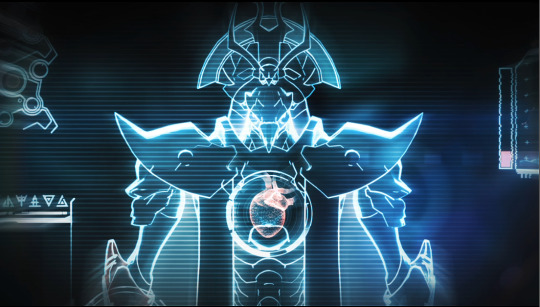
This is anatomically accurate to real birds! Bird hearts are placed similarly in the center of the chest, flanked by the left and right lobes of the liver (linked image is a labeled black and white illustration of a dissected pigeon, showing most of the major organs).
The brain is exactly what you think it is. No, the most interesting part of this last image set is the harus.
The harus is an accessory to the lymphatic system. You'll notice its proximity to the respiratory system. Lymphatic capillaries accompanying the parabronchi network filter more harmful atmospheric molecules into the harus, which makes use of specialized cells to recycle these molecules in a process that synthesizes ATP. In addition to this, the harus helps maintain the body's proper pH levels in hostile environments. This organ is what allows the Thoha to breathe in Zebes' toxic atmosphere.
Headcanon time: the majority of non-powersuit related genetic alteration done to Samus Aran in her youth is related to this organ: her respiratory system was altered with the proper instructions to produce specialized harus cells on their own without needing to transplant the organ. Samus can breathe on Zebes because her lungs can perform the function of the harus while she breathes.
Full-size pngs for everything are available on Ko-fi and Patreon. The canvas for this project was pretty big because I wanted to be able to capture the scale of the wings somewhat.
ADDENDUM, May 16, 2024: Chozo should have a modified pelvic bone that more closely resembles a synsacrum, not a humanoid ilium: I am a fool and completely forgot to make alterations in that department.
#headcanons#chozo anatomy#chozo#raven beak#metroid#metroid dread#metroid dread spoilers#gotta give props to friend of the blog Ivory who reminded me of ATP synthesis and suggested a second liver of sorts
93 notes
·
View notes
Text
Am right outside the Hanubia EMMI zone. Saw the cutscene. Oh Boy That Aint Good Is It.
9 notes
·
View notes
Text
why the fuck would the chozo from metroid count in base ten? they have FOUR talons on each hand, not five why decimal? WHERES MY EXPLANATION NINTENDO
10 notes
·
View notes
Text
youtube
Highlight of the stream (7/21)
11 notes
·
View notes
Text
So I just beat Metroid Dread a couple days ago and I have had a rather stupid realization. If someone makes the joke of saying Samus' name is "Metroid", they technically aren't wrong anymore.
13 notes
·
View notes
Note
NO FOR REAL HOLLY RENAUT (the voice actress who did the scream) PUT HER WHOLE PUSSY INTO IT. THEY SAID SAMUS NEEDS TO SCREAM IN PURE ANGER AND SHE DELIVERED
Top 10. Woman moments:
youtube
#Samus deserved to rip apart the face of Raven Beak#as a treat#she deserves to rip apart at least three more faces tbh#metroid dread#do i still tag this as#metroid dread spoilers#when the game is like 2 years old?
8 notes
·
View notes
Text
Metroid Dread spoilers
The fact they had Samus be completely silent other than a few text only narrations only to have her suddenly bust out a fully voiced line in Chozo instead of English: mwah no notes.
27 notes
·
View notes
Text
Metroid: Dread and LoZ: Echoes of Wisdom shaking hands, bc both made "the playable protagonist is now the name of the series, so saying the main character is Metroid or Zelda is no longer inaccurate" like, actual canon
#metroid dread spoilers#I mean ''Samus is Metroid'' is technically spoilers for Dread but it's been out for a while now so...#anyhow can't believe both series have been around long enough that the writers were finally like#''fuck it the main characters IS [insert series' title key word]''#anyhow very excited for next week...#took some time off work using sick leave bc I don't get PTO and between sleeping and EoW I'm very excited#juuuuust have to get through this work week...(<-- does not want to go to work bc sleepy)#oracle of lore
2 notes
·
View notes
Text
I think Metroid Dread's Super Missile is the worst upgrade in the 2D series.
The Super Missile in metroid games is typically a separate weapon from normal missiles, accessed via weapon select in Zero Mission, AM2R & Samus Returns, and Super Metroid, or via charge beam combo in the Prime games. In all games it functions as a hard key (it opens locks it's specifically designed to bypass), and in the mentioned 2D games it's a super weapon with far more limited ammo than normal missiles. Prime's super missile is primarily useful in combat for single-shot burst damage, especially against mobile targets, versus the barrage you'd normally use in a 2D game.
The super missile in those 2D games is a rather rewarding upgrade to collect expansions for, since with enough of them you can dispatch a boss with minimal worry. It's basically the epitome of Metroid's self-selecting difficulty, where the more you collect the easier the end game gets.
Fusion & Dread, however, both opt for super missiles as just "upgrades" to basic missiles, so they don't have a separate ammo count. This effectively means that the developers don't need to account for how many normal missiles a given boss or enemy will take to kill, so they mainly just function as hard keys.
Despite their similar function, however, Dread's super missiles just feel superfluous, while Fusion's don't. Some of that comes down to design, some of it to the context the upgrade gets collected in:
There are basically no super missile doors in the game. There's no point prior to getting the upgrade that you see a green door and resolve to come back with super missiles, except for the door that forces you to head in their direction in the first place.
Immediately following the super missiles in the normal route, all enemies in the world get upgraded and account for you having super missiles.
The game just sort of shoves you in the direction of the upgrade with a bunch of points of no returns.
If you grab the super missiles early, they'll benefit you for one boss before you're back on track
Fusion, despite its super missile serving a similar point (and not having an equivalent sequence break as far as I'm aware), feels better because of the narrative surrounding it.
In Fusion the computer provides the super missile to Samus as a counter measure to the X taking on more resilient forms to seal off areas. It's more of a narrative beat than an upgrade (especially with the BOX fight following it), similar to the diffusion missiles in the same game.
How effective that narrative element is will vary from player to player, but Dread simply lacks it while trying to not-too-subtly shove you after an upgrade without explicitly telling you to grab it.
Honestly, Dread could probably have cut the super missile and funneled Samus directly into Elun without it and nobody would have batted an eye (and it would make the constant point-of-no-returns make a bit more sense).
Alternatively, the super missile could have been given more weight and put as a "reward" for Samus in a chozo combat shrine in Ghavoran or something to that effect. Maybe have a Mawkin Torizo as a mini-boss there (with Samus defeating it being the moment that Raven Beak decides to push her to Elun and unleash the X, deeming her "strong enough" to need them to awaken her Metroid DNA further now).
4 notes
·
View notes
Text
oopsie

Daily drawing practice day 890 (9/5/24)
Tried to redesign Dread's Metroid Suit to make it look more like an adult metroid, accidentally made Dark Samus.
526 notes
·
View notes
Text

























I found a very good Wikihow article the other day.
72 notes
·
View notes